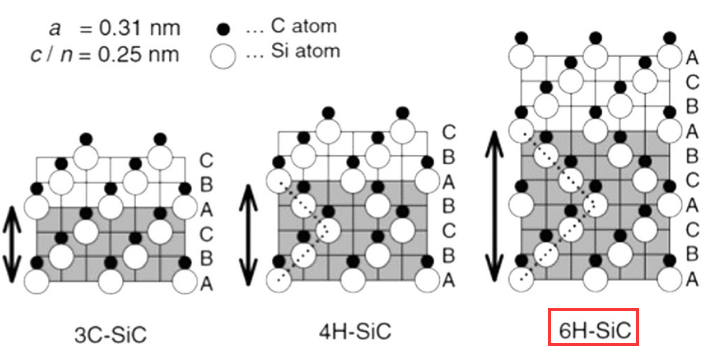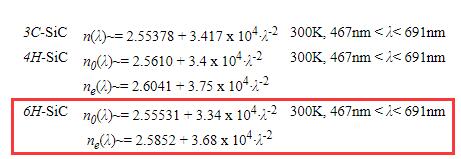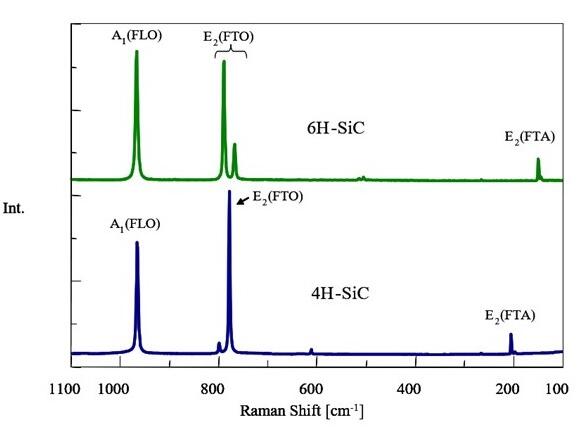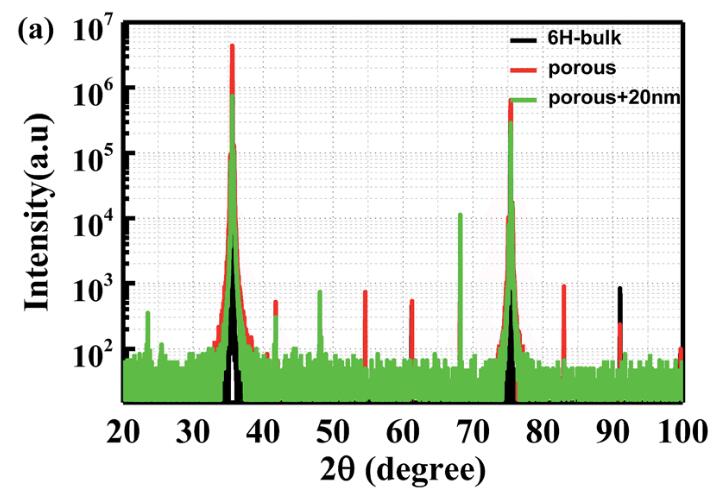PAM-XIAMEN can offer 6H SiC wafer with n type or semi-insulating. Silicon carbide wafer is a material presenting different crystalline structures called polytypes, which has more than 250 structures. Different polytypes has different atomic stacking sequences. Polytypes generate the cubic, hexagonal or rhombohedral structures, which include 50% C atoms bonded with 50% Si atoms. Nevertheless, only hexagonal structures of 4H-SiC and 6H-SiC and the cubic structure of 3C-SiC can be for commercial use. Here we make a brief introduction as follows:
1. Specifiaction of 2” 6H SiC Wafer
| SILIKONKARBID-WAFER 50,8MM (2”) 6H, N-Typ | |
| Oberflächenorientierung | (0001), Si-Seite |
| Off-Orientierung | (0,0 ± 0,5)° |
| Durchmesser | (50,8 ± 0,38) mm |
| Nenndicke | (330 ± 25) um |
| Dickentoleranz (TTV) | ≤ 10 um |
| MPD | ≤15/cm3 |
| Bogen | ≤ 10 um |
| Kette | ≤ 25 um |
| Rauheit der Vorder- und Rückseite | Ra < 0,5 nm |
| Hauptwohnung | Ja |
| Primäre flache Orientierungs | (11-20) ± 5° |
| Primäre flache Länge | (16 ± 1,65) mm |
| Zusätzliche Wohnung | Ja |
| Zusätzliche flache Länge | (8 ± 1,65) mm |
| Fase | Ja |
| Paket | Einzel- oder Mehrstückverpackung Typ EPAK,
Vakuumverpackung |
| Zusatzabflachung ist um (90 ± 5)° gegenüber der Hauptabflachung cw (von der Vorderseite) gedreht | |
2. 6H SiC-Kristallstruktur
Die SiC 6H-Struktur ist eine hexagonale Wurtzit-Kristallstruktur. Es bezieht sich auf eine Stapelsequenz von AαBβCγAαCγBβ, die aus 2/3 kubischen Bindungen und 1/3 hexagonalen Bindungen besteht, und die C-Atome relativ zur Lage der Si-Atome sind fixiert. Die Abbildung ist unten dargestellt:

3. Grundparameter von 6H SiC
1) 6H-SiC-Gitterkonstante, siehe Highlight-Teil:

2) Infrarot-Brechungsindex von 6H-SiC, siehe Highlight-Teil:

3) Brechungsindex n(λ), siehe Highlight-Teil:

4) Vergleich von 6H-SiC-Raman-Spektren und 4H-SiC-Raman-Spektren

5) 6H-SiC-XRD-Diagramm

4. Ähnlichkeiten zwischen den Polytypen von 6H-SiC, 4H-SiC und 3C-SiC in Anwendungen
Although different polytypes have different properties, there are similarities in tendency. The silicon carbide breakdown field is 2-4 MV/cm, and the silicon carbide energy bandgap is 2.3-3.2eV, which are higher than that of silicon. Therefore, silicon carbide is a wide bandgap material. Combing the two properties makes a great superiority for electrical equipments with a low on resistance and low leakage current. Moreover, the saturated electron velocity of SiC material is high. It is a very important parameter for high frequency application. Besides, the thermal conductivity of silicon carbide is about 3 times higher than silicon, which is beneficial for high temperature devices. This property has an advantage over the wide bandgap material(like GaN). And silicon carbide substrates can be used to grow graphene layers by thermal decomposition under ultra-high vacuum conditions.
5. Difference Between 4H and 6H SiC Wafer
1) Der kommerzielle spezifische Widerstand von 6H n-SiC-Wafern beträgt (0,02 ~ 0,1) Ohm.cm, während 4H (0,015 ~ 0,028) Ohm.cm beträgt.
2) Stapelsequenz von 6H SiC-Substrat ist ABCACB, während 4H-Substrat ABCB . ist
3) Die Wärmeleitfähigkeit von halbisolierendem 6H SiC beträgt ~460W/mK und c~320W/mk, während 4H eine ~490W/mK und c~390W/mK beträgt. Für n-Typ-SiC, seine Wärmeleitfähigkeit, nehmen Sie 4H als Beispiel, a~420W/mK und c~370W/mK, was viel niedriger ist als bei halbisolierendem. Aus diesem Grund wählt der Endverbraucher halbisolierendes SiC als Wärme Spüle oder anderes leitfähiges Material.
4) Die 6H-SiC-Bandlücke beträgt 3,02 eV, während die 4H-Bandlücke 3,23 eV beträgt.
5) Die Lochbeweglichkeit des 6H SiC-Substrats beträgt 90 cm2/Vs, während das 4H-Substrat ~ 115 cm2/Vs beträgt
6) Die Elektronenmobilität des 6H-SiC-Wafers beträgt ~400 cm2/Vs, während der 4H-Wafer ~800 cm2/Vs beträgt
6. FAQ about 6H-SiC Wafer
F1: If the Thermal Conductivity of SiC-4H N-type is 420 W/mK -What is the Thermal Conductivity of your SiC-6H N-type material ?
A: Theoretically it is the same between 6H and 4H.
F2: I am curious about this because one of the reviewer of my paper wants to know the surface roughness before CMP. Could you tell me the surface roughness of the original 6H-SiC wafer before CMP processed?
A: The surface roughness of 6H-SiC wafer is <1nm before CMP after mechanical polishing.
Für weitere Informationen kontaktieren Sie uns bitte per E-Mail unter victorchan@powerwaywafer.com und powerwaymaterial@gmail.com.

